Catholic Virtues
 |
 |
 |
 |
 |
 |
 |
True & False Paths to Happiness - XXVIII
An Exercise of Transcendence:
The Castle of La Mota
In my last article I explained how a Catholic should seek aspects of the absolute in the things of Creation in order to transcend them and reach the Absolute, God himself. In this article we will make an exercise of transcendence: the Castle of La Mota.
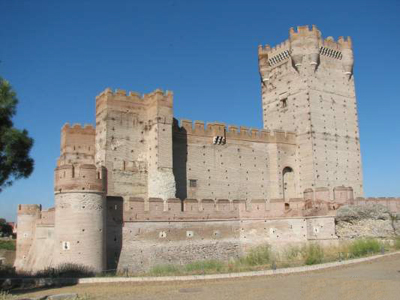 The Castillo de La Mota is located in the town of Medina del Campo in the Province of Valladolid, Spain. Situated on a small hill or cliff – la mota – it dominates the city and all the surrounding region. It was constructed during the 13th, 14th and 15th centuries on the remains of a 12th century Muslim fortress.
The Castillo de La Mota is located in the town of Medina del Campo in the Province of Valladolid, Spain. Situated on a small hill or cliff – la mota – it dominates the city and all the surrounding region. It was constructed during the 13th, 14th and 15th centuries on the remains of a 12th century Muslim fortress.
The current castle was ordered to be built by King John II of Castile in 1440. During the reign of the Catholic Monarchs – Ferdinand II of Aragon and Isabella I of Castile (1473-1504) – the Castle was fortified and became the best European castle of its kind. It used the pinkish brick characteristic of the region, with stone applied in some details.
The exercise of transcendence consists of three phases: It begins with a description; it goes on to what we call exclamation or an express impression; finally transcendence itself is reached.
1. The description
There are three elements in the panorama: the castle, the sky and the tree.
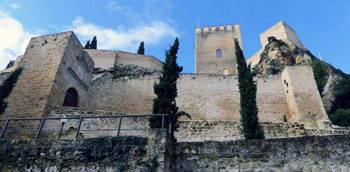 In the castle, which is evidently the dominant note, we find two kinds of elements: the walls, including the turrets that stand out on it, and the great corner tower, which is at one end of the structure and is completely different from the walls. Evidently, this tower is the dominant note of the walls and, therefore, it is the dominant note of the whole.
In the castle, which is evidently the dominant note, we find two kinds of elements: the walls, including the turrets that stand out on it, and the great corner tower, which is at one end of the structure and is completely different from the walls. Evidently, this tower is the dominant note of the walls and, therefore, it is the dominant note of the whole.
Let us begin by analyzing the secondary elements: the walls and turrets that constitute part of the Castle of Mora.
The walls are high, well-crafted, beautiful, dignified, proud. But if there were only these walls in this picture, I do not believe there would be nothing extraordinary about it. These walls have only the real but common beauty of many medieval monuments of this type; there are much more beautiful walls than these.
For my taste, a dark stone, a more grave and serious material, would better express what a wall like this should express. This light and slightly shimmering stone, which takes on a greater sheen in the sunlight, has a festive look rather than strictly military presence, as its purpose calls for.
It is a wall that of itself does not say much. It is placid and calm, and extends in a kind of rectangle, without major movement or flight of fantasy. The towers are interspersed symmetrically, simply obeying a military demand, without any particular aesthetic concern.
In contrast, we see the tall tower. It is imposing, defiant. It rises high above the rest of the wall, making the wall seem almost like the veil or mantle that hangs from the crown of a queen. It is the truly dominant note. The turrets at the corner of that tower confer to it a distinctive appearance. It stands tall, but at the same time is stocky, strong, firm, as if to say: I watch from on high, I challenge, I resist. I fear nothing.
It appears to me to say: My prow is ready to cut through the waves of the adversaries like the bow of a ship cuts across the seas. I have no doubts or hesitancy. I am disposed to resist at every turn, in every test of strength. No one can tear me down. Not even if I am abandoned, isolated, removed from any military use, I am still a living proclamation of the ideals I served.
One can almost say that through the centuries it stands, awaiting new adversaries in order to render new services to the same ideals. For it, time, being abandoned by men, changing circumstances, all mean nothing. It is, now and tomorrow. It waits tranquilly for the end of the world and does not fear the judgment of God.
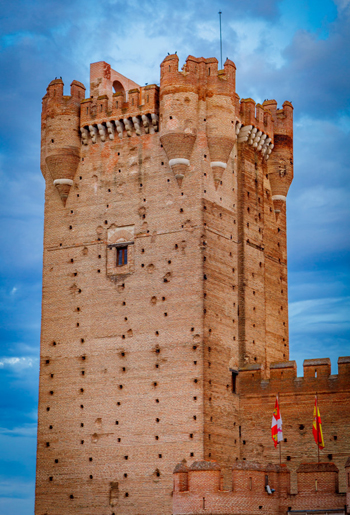 It is an affirmation of a state of mind, the tranquil conscience of one who walks toward death and eternity without worrying about it.
It is an affirmation of a state of mind, the tranquil conscience of one who walks toward death and eternity without worrying about it.
This is how I see the physiognomy of this tower.
I note again that I think that the difference in its height as well as the poetry, fantasy, imagination of the tower in contrast to the walls is immense. The tower stands out.
But, at the same time, this Castle as it so stands in my view gives the impression of a skeleton burnt by the sun. One has the impression that it is more or less abandoned, and one perceives that daily life no longer plays out in it. For this reason, it produces the sensation of an great shipwreck, whose sadness and abandonment is accentuated by the splendor of the sun and the light.
The light strikes it, all of nature rejoices around it, indifferent to the sadness of the Castle. The Castle is proud but, at the same time, sad. It is not in ruins, but something about it announces the ruin of an order of things that once existed inside it. On the other hand, the sun and the light communicate a certain joy to the Castle, which gives the impression of a hope of revival.
There is a certain melancholy in the Castle, and also a yo vuelveré (I will return), which produces an ambiguous impression. One is not certain whether it is of victory or of tragedy. It appears to me to be a combination of the two.
The tree at the side communicates a little life to the panorama as a whole. If we imagined the picture without the tree, this impression of displacement and abandonment would be even more accentuated. One could say that a little sap, a certain smile of concrete life, leans against the old Castle and gives some animation to what is so stiff, so burnt by the sun.
2. The exclamation
That is the description. Could one synthesize what was just described in an exclamation? In my opinion, it would extol stability.
During the First World War, General Pétain defended Verdun, which was being violently attacked; the Germans were making successive attacks on his troops. He was asked what he would do in face of this. He replied, with French conciseness, J'y suis, j'y reste (I am here, and here I remain).
And, in fact the German waves crashed uselessly against the resistance of his troops. The Germans were forced to retreat. I would say the same words about this Castle: J'y suis, j'y reste.
The tower hovers above everything; in its simplicity, it makes an outstanding statement, where one notes stability. The tower looks out above all the adversaries, but, at the same time it clings to the ground and seems to say: This ground is mine, and no one can take it away from me. I remain.
A towering determination, high and firm. This is the exclamation that I see arises from the scene.
One thing is the height of Pétain, another is that of a medieval tower. Here is the resistance and stability not of a man, in this case, of Pétain, but of an era, a civilization, a culture. It is, in final analysis, the stability and elevation of the Catholic Faith.
Whoever does not believe in eternal life is not capable of having this kind of highness and stability. It is not to compare oneself with the adversary and conclude: "I am more." Rather, it is, so to speak, to touch the sky and exclaim, "The sky I touch is incomparably more. I represent it here. I represent God Our Lord. I represent sacrality against the hordes of the Mohammedans who invade."
It is, therefore, a sacral height, a sacral stability. It is sacrality that, for me, is expressed strongly in that tower.
3. The act of transcendence
Transcendence can be achieved by remembering that the Crusaders were here. But where does the Catholic soul express itself?
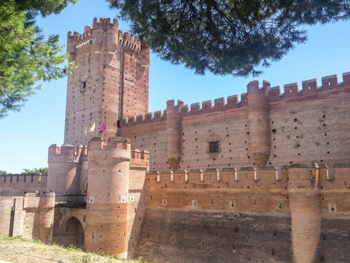 It is found, for example, in the upper part of this tower. It is very smooth, atop it are the battlements and turrets, and there is something, somewhat difficult to express, that leads upward. This marks the sacrality of the Castle of Mora.
It is found, for example, in the upper part of this tower. It is very smooth, atop it are the battlements and turrets, and there is something, somewhat difficult to express, that leads upward. This marks the sacrality of the Castle of Mora.
The harmonic contrast between height and stability also expresses, in some way, the sacrality of the Castle. Something indefinable of the Catholic soul is present here. One could say: "O Catholic elevation, O Catholic stability, O Divine Holy Spirit, stable and towering at the same time!"
It is the transcendence that turns toward the Holy Spirit, with a projection for the future.
The time passed, and castles began to be built without towers. And then, naturally, there were no more castles. Then, when military art moved to the trenches, the cockroach and mud war began...
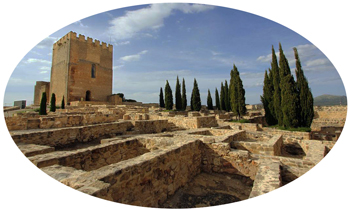
Continued


The Castle of La Mota is in Medina del Campo, Spain
The current castle was ordered to be built by King John II of Castile in 1440. During the reign of the Catholic Monarchs – Ferdinand II of Aragon and Isabella I of Castile (1473-1504) – the Castle was fortified and became the best European castle of its kind. It used the pinkish brick characteristic of the region, with stone applied in some details.
The exercise of transcendence consists of three phases: It begins with a description; it goes on to what we call exclamation or an express impression; finally transcendence itself is reached.
1. The description
There are three elements in the panorama: the castle, the sky and the tree.

The walls and turrets are of a common type
Let us begin by analyzing the secondary elements: the walls and turrets that constitute part of the Castle of Mora.
The walls are high, well-crafted, beautiful, dignified, proud. But if there were only these walls in this picture, I do not believe there would be nothing extraordinary about it. These walls have only the real but common beauty of many medieval monuments of this type; there are much more beautiful walls than these.
For my taste, a dark stone, a more grave and serious material, would better express what a wall like this should express. This light and slightly shimmering stone, which takes on a greater sheen in the sunlight, has a festive look rather than strictly military presence, as its purpose calls for.
It is a wall that of itself does not say much. It is placid and calm, and extends in a kind of rectangle, without major movement or flight of fantasy. The towers are interspersed symmetrically, simply obeying a military demand, without any particular aesthetic concern.
In contrast, we see the tall tower. It is imposing, defiant. It rises high above the rest of the wall, making the wall seem almost like the veil or mantle that hangs from the crown of a queen. It is the truly dominant note. The turrets at the corner of that tower confer to it a distinctive appearance. It stands tall, but at the same time is stocky, strong, firm, as if to say: I watch from on high, I challenge, I resist. I fear nothing.
It appears to me to say: My prow is ready to cut through the waves of the adversaries like the bow of a ship cuts across the seas. I have no doubts or hesitancy. I am disposed to resist at every turn, in every test of strength. No one can tear me down. Not even if I am abandoned, isolated, removed from any military use, I am still a living proclamation of the ideals I served.
One can almost say that through the centuries it stands, awaiting new adversaries in order to render new services to the same ideals. For it, time, being abandoned by men, changing circumstances, all mean nothing. It is, now and tomorrow. It waits tranquilly for the end of the world and does not fear the judgment of God.

It is the tower that is distinctive and invites us to transcendence
This is how I see the physiognomy of this tower.
I note again that I think that the difference in its height as well as the poetry, fantasy, imagination of the tower in contrast to the walls is immense. The tower stands out.
But, at the same time, this Castle as it so stands in my view gives the impression of a skeleton burnt by the sun. One has the impression that it is more or less abandoned, and one perceives that daily life no longer plays out in it. For this reason, it produces the sensation of an great shipwreck, whose sadness and abandonment is accentuated by the splendor of the sun and the light.
The light strikes it, all of nature rejoices around it, indifferent to the sadness of the Castle. The Castle is proud but, at the same time, sad. It is not in ruins, but something about it announces the ruin of an order of things that once existed inside it. On the other hand, the sun and the light communicate a certain joy to the Castle, which gives the impression of a hope of revival.
There is a certain melancholy in the Castle, and also a yo vuelveré (I will return), which produces an ambiguous impression. One is not certain whether it is of victory or of tragedy. It appears to me to be a combination of the two.
The tree at the side communicates a little life to the panorama as a whole. If we imagined the picture without the tree, this impression of displacement and abandonment would be even more accentuated. One could say that a little sap, a certain smile of concrete life, leans against the old Castle and gives some animation to what is so stiff, so burnt by the sun.
2. The exclamation
That is the description. Could one synthesize what was just described in an exclamation? In my opinion, it would extol stability.
During the First World War, General Pétain defended Verdun, which was being violently attacked; the Germans were making successive attacks on his troops. He was asked what he would do in face of this. He replied, with French conciseness, J'y suis, j'y reste (I am here, and here I remain).
And, in fact the German waves crashed uselessly against the resistance of his troops. The Germans were forced to retreat. I would say the same words about this Castle: J'y suis, j'y reste.
The tower hovers above everything; in its simplicity, it makes an outstanding statement, where one notes stability. The tower looks out above all the adversaries, but, at the same time it clings to the ground and seems to say: This ground is mine, and no one can take it away from me. I remain.
A towering determination, high and firm. This is the exclamation that I see arises from the scene.
One thing is the height of Pétain, another is that of a medieval tower. Here is the resistance and stability not of a man, in this case, of Pétain, but of an era, a civilization, a culture. It is, in final analysis, the stability and elevation of the Catholic Faith.
Whoever does not believe in eternal life is not capable of having this kind of highness and stability. It is not to compare oneself with the adversary and conclude: "I am more." Rather, it is, so to speak, to touch the sky and exclaim, "The sky I touch is incomparably more. I represent it here. I represent God Our Lord. I represent sacrality against the hordes of the Mohammedans who invade."
It is, therefore, a sacral height, a sacral stability. It is sacrality that, for me, is expressed strongly in that tower.
3. The act of transcendence
Transcendence can be achieved by remembering that the Crusaders were here. But where does the Catholic soul express itself?

The tower that hovers above the battlements & turrets
The harmonic contrast between height and stability also expresses, in some way, the sacrality of the Castle. Something indefinable of the Catholic soul is present here. One could say: "O Catholic elevation, O Catholic stability, O Divine Holy Spirit, stable and towering at the same time!"
It is the transcendence that turns toward the Holy Spirit, with a projection for the future.
The time passed, and castles began to be built without towers. And then, naturally, there were no more castles. Then, when military art moved to the trenches, the cockroach and mud war began...

Continued

Posted April 30, 2021





